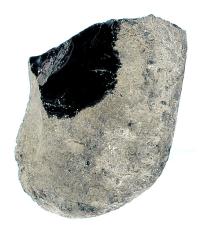Exotic Volcanic Glass |
|||
|
|
|||
|
Obsidian cobble (not from site). Photo by Milton Bell. |
Among the thousands of pieces of flint chipping debris recovered from the workshop area at the southern edge of the Graham-Applegate site were three small flakes of volcanic glass, or obsidian. Someone a thousand years ago was chipping an obsidian tool—a knife or scraper, perhaps—or maybe resharpening such a tool by removing flakes along one edge. In any case, the tool was a treasured object to its owner, made from a black, transparent stone of unusual beauty and flaking properties that few other people in Late Prehistoric central Texas possessed, a rock that we currently believe comes from an outcrop almost a thousand miles away. Obsidian does not occur naturally in central Texas. The volcanic activity required for its formation has not taken place here in recent geological times, and earlier periods of volcanism did not leave obsidian outcrops. The Indian people of central Texas could only acquire this rock through trade or as spoils of war. Small amounts of obsidian were traded out from a number of different and widely spaced sources in western North America, being passed from one individual to the next, becoming scarcer and more valuable as the distance traveled increased. By the time what was likely a very small piece of volcanic glass reached central Texas, it was probably a highly sought-after exotic material. The good news for archeologists is that obsidian is traceable to its place of origin. Each geologic formation of obsidian has it own unique set of trace elements, a chemical signature that can be read in any piece of material taken from it. While you might expect that prehistoric people in central Texas acquired obsidian from the nearest sources (for example, sources in far west Texas and New Mexico), most volcanic glass found in Late Prehistoric sites in central Texas has been traced back to outcrops far to the north—in Wyoming or Idaho. The obsidian flakes found at the Graham-Applegate site await final interpretation of analyses; preliminary results, however, suggest they may have come from the Mineral Mountains in southwestern Utah. |
||
|
Obsidian flakes and a core (not from site). Photo by Milton Bell. |
|||

